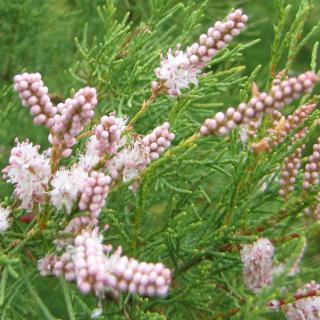

Tamarisk is a spring-blooming or summer-blooming shrub that is well known for its pale pink flowers. Ideal for seaside gardens thanks to wind and salt resistance.
Name – Tamarix
Family – Tamaricaceae
Type – shrub
Height – 6 ½ to 16 feet (2 to 5 meters)
Climate – rather warm
Exposure – full sun
Soil – ordinary
Flowering – April to May and August-September
Foliage – deciduous
Invasive in – Australia, USA, Canada
It often grows wild and self-sows, but you can also plant it in your garden if you live where it is native to.
Tamarisk is planted preferably in fall but also until spring it if doesn’t freeze in your area.
This moderately hardy shrub resists freezing and cold down to more or less 23°F (-5°C).
Tamarisk requires abundant watering upon planting, and thick mulch that will reduce the risk of freezing for the soil and roots.
The speediest tamarisk propagation technique is to prepare tamarisk cuttings.
Once it’s well established, it will release thousands of seeds every year: a very prolific shrub!
Pruning is an important step for tamarisk because it guides growth for the shape to stay rather compact and it ensures better blooming.
Tamarisk requires very little work because it lives very comfortably on dry terrain, and doesn’t need any watering after the first year.

In Europe, it essentially grows in the South, but it also appears along the Atlantic coast, especially thanks to its high tolerance to sea spray.
Wind makes this shrub particularly attractive, as it sways and dances with the wispy branches… a show that one never tires to admire.
However, it is quite vulnerable to frost and suffers when temperatures drop below 23°F (-5°C).
The different varieties mostly flower in spring, with many pink or white colored flowers, but some cultivars also bloom in summer, sometimes even into fall.
Leaves are small, alternate and scaly, quite like those of certain conifers.
It has been said that the “manna” collected by the Hebrews as they crossed the desert (book of Exodus) comes from this shrub.
Lastly, note that tamarisk is a highly invasive shrub in some parts of the world.
Read also:
Tamarisks make for magnificent hedges, especially along the seaside where the wind plays with the shrub and enhances its beauty.
I read once that you should prune down to 6-8 inches at the end of winter before the spring arrives. What do you think?
I have two shrubs that made it through the summer despite Japaneese Beetles Will they make it through the winter? I live in southern Ontario Canada
It’s really borderline for them. Usually they have trouble when the temperature drops below 20-25°F (-5°C), and in the winter in Southern Ontario it gets colder than that. They’ll survive if you take steps to winterize them: insulate them, spread thick hay on the ground around them, etc. Since you’re at the threshold, there’s a big chance they’ll survive with even just a little help!
Also, some varieties are hardier than others: if you’ve purchased yours from a nearby nursery, they’ve probably selected a hardier variety.
Why is my Tamarisk plant starting to go a bit yellow it’s a new plant which I water regularly and until recently seemed to be doing cwell
Hi, is it growing in a pot? If so, maybe the watering isn’t adequate. On one hand, it’s important to make sure there’s proper drainage: water should drain out from the bottom of the pot after watering. On the other, it isn’t good to let the soil dry out for more than 2-3 days, especially in hot weather.
If it’s in the ground, make sure it’s in a spot where water doesn’t accumulate. Rainwater should drain away to a sink hole or along a slope further away. If you don’t have much of a choice, perhaps try replanting the shrub a bit “higher up” by raising the soil and planting it on a mound. That way, as in any raised garden bed, excess water will just drain away.
Hi
Thank you for your advice (which I have taken) my tamarisk is in a pot so I have watered it until the water runs out of the bottom of the pot, I’ll keep an eye on the plant and hopefully it will recover.
Sure! Definitely hope it’ll turn out for the better! Since the drainage works well, it’s all up to making sure it gets the right amount of water.
If it’s a new plant, the soil should still have enough nutrients for a couple more months. Usually soil nutrients in potted plants deplete after about 6 months. After this time, it helps to add a little fertilizer from time to time, like twice a month in Summer and once a month in Winter, and then back to twice a month in Spring once the plant starts growing again after the winter dormancy.
Invasive species! Best not to plant anywhere
Hello Cheryl! It took me a few weeks to get the information I needed to answer you… You’re perfectly right that tamarisk is invasive in may parts. Here is an article that shows where tamarisk is native and invasive. Thanks for helping me dig into it!